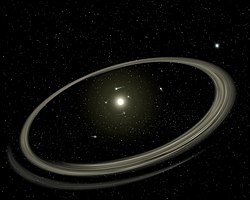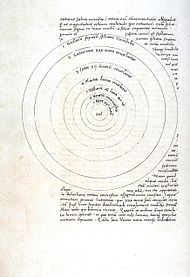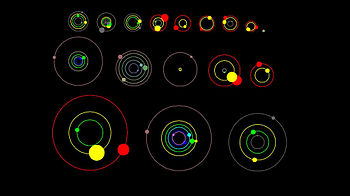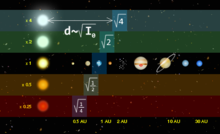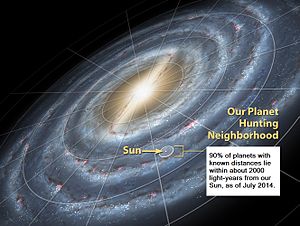An artist's concept of a planetary system
A planetary system is a set of gravitationally bound non-stellar objects in or out of
orbit around a star or star system. Generally speaking, systems with one or more planets constitute a planetary system, although such systems may also consist of bodies such as dwarf planets, asteroids, natural satellites, meteoroids, comets, planetesimals and circumstellar disks. The Sun together with its planetary system, which includes Earth, is known as the Solar System. The term exoplanetary system is sometimes used in reference to other planetary systems.
As of 1 December 2018, there are 3,903 confirmed planets in 2,909 systems, with 647 systems having more than one planet. Debris disks are also known to be common, though other objects are more difficult to observe.
Of particular interest to astrobiology is the habitable zone of planetary systems where planets could have surface liquid water, and thus the capacity to harbor Earth-like life.
History
Heliocentrism
Historically, heliocentrism (the doctrine that the Sun is the center of the universe) was opposed to geocentrism (placing the Earth at the center of the universe).
The notion of a heliocentric Solar System, with the Sun at the center, is possibly first suggested in the Vedic literature of ancient India, which often refer to the Sun as the "centre of spheres". Some interpret Aryabhatta's writings in Āryabhaṭīya as implicitly heliocentric.
The idea was first proposed in Western philosophy and Greek astronomy as early as the 3rd century BC by Aristarchus of Samos, but received no support from most other ancient astronomers.
Discovery of the Solar System
De revolutionibus orbium coelestium by Nicolaus Copernicus, published in 1543, was the first mathematically predictive heliocentric model of a planetary system. 17th-century successors Galileo Galilei, Johannes Kepler, and Isaac Newton developed an understanding of physics
which led to the gradual acceptance of the idea that the Earth moves
round the Sun and that the planets are governed by the same physical
laws that governed the Earth.
Speculation on extrasolar planetary systems
In the 16th century the Italian philosopher Giordano Bruno, an early supporter of the Copernican
theory that the Earth and other planets orbit the Sun, put forward the
view that the fixed stars are similar to the Sun and are likewise
accompanied by planets. He was burned at the stake for his ideas by the Roman Inquisition.
In the 18th century the same possibility was mentioned by Isaac Newton in the "General Scholium" that concludes his Principia.
Making a comparison to the Sun's planets, he wrote "And if the fixed
stars are the centers of similar systems, they will all be constructed
according to a similar design and subject to the dominion of One."
His theories gained traction through the 19th and 20th centuries
despite a lack of supporting evidence. Long before their confirmation
by astronomers, conjecture on the nature of planetary systems had been a
focus of the search for extraterrestrial intelligence and has been a prevalent theme in fiction, particularly science fiction.
Detection of exoplanets
The first confirmed detection of an exoplanet was in 1992, with the discovery of several terrestrial-mass planets orbiting the pulsar PSR B1257+12. The first confirmed detection of exoplanets of a main-sequence star was made in 1995, when a giant planet, 51 Pegasi b, was found in a four-day orbit around the nearby G-type star 51 Pegasi. The frequency of detections has increased since then, particularly through advancements in methods of detecting extrasolar planets and dedicated planet finding programs such as the Kepler mission.
Origin and evolution
An artist's concept of a protoplanetary disk
Planetary systems come from protoplanetary disks that form around stars as part of the process of star formation.
During formation of a system much material is gravitationally
scattered into far-flung orbits and some planets are ejected completely
from the system becoming rogue planets.
Evolved systems
High-mass stars
Planets orbiting pulsars have been discovered. Pulsars are the remnants of the supernova
explosions of high-mass stars, but a planetary system that existed
before the supernova would likely be mostly destroyed. Planets would
either evaporate, be pushed off of their orbits by the masses of gas
from the exploding star, or the sudden loss of most of the mass of the
central star would see them escape the gravitational hold of the star,
or in some cases the supernova would kick
the pulsar itself out of the system at high velocity so any planets
that had survived the explosion would be left behind as free-floating
objects. Planets found around pulsars may have formed as a result of
pre-existing stellar companions that were almost entirely evaporated by
the supernova blast, leaving behind planet-sized bodies. Alternatively,
planets may form in an accretion disk of fallback matter surrounding a pulsar. Fallback disks of matter that failed to escape orbit during a supernova may also form planets around black holes.
Lower-mass stars
Protoplanetary discs observed with the Very Large Telescope.
As stars evolve and turn into red giants, asymptotic giant branch stars and planetary nebulae
they engulf the inner planets, evaporating or partially evaporating
them depending on how massive they are. As the star loses mass, planets
that are not engulfed move further out from the star.
If an evolved star is in a binary or multiple system then the
mass it loses can transfer to another star, creating new protoplanetary
disks and second- and third-generation planets which may differ in
composition from the original planets which may also be affected by the
mass transfer.
- Planets in evolved binary systems, Hagai B. Perets, 13 Jan 2011
- Can Planets survive Stellar Evolution?, Eva Villaver, Mario Livio, Feb 2007
- The Orbital Evolution of Gas Giant Planets around Giant Stars, Eva Villaver, Mario Livio, 13 Oct 2009
- On the survival of brown dwarfs and planets engulfed by their giant host star, Jean-Claude Passy, Mordecai-Mark Mac Low, Orsola De Marco, 2 Oct 2012
- Foretellings of Ragnarök: World-engulfing Asymptotic Giants and the Inheritance of White Dwarfs, Alexander James Mustill, Eva Villaver, 5 Dec 2012
System architectures
The Solar System consists of an inner region of small rocky planets and outer region of large gas giants.
However, other planetary systems can have quite different
architectures. Studies suggest that architectures of planetary systems
are dependent on the conditions of their initial formation. Many systems with a hot Jupiter gas giant very close to the star have been found. Theories, such as planetary migration or scattering, have been proposed for the formation of large planets close to their parent stars.
At present, few systems have been found to be analogous to the Solar
System with terrestrial planets close to the parent star. More commonly,
systems consisting of multiple Super-Earths have been detected.
Components
Planets
The three known planets of the star HR8799, as imaged by the Hale Telescope. The light from the central star was blanked out by a vector vortex coronagraph.
Some studies suggest that there is at least one planet on average per star. This would suggest that, like the Solar System, most stars have planets (or exoplanets).
However, the proportion of stars is uncertain because not all planets
can yet be detected. The radial-velocity method and the transit method
(which between them are responsible for the vast majority of detections)
are most sensitive to large planets in small orbits. Thus, many known
exoplanets are "hot Jupiters": planets of Jovian
mass or larger in very small orbits with periods of only a few days. A
2005 survey of radial-velocity-detected planets found that about 1.2% of
Sun-like stars have a hot Jupiter, where "Sun-like star" refers to any
main-sequence star of spectral classes late-F, G, or early-K without a close stellar companion.
This 1.2% is more than double the frequency of hot jupiters detected by
the Kepler spacecraft, which may be because the Kepler field of view
covers a different region of the Milky Way where the metallicity of
stars is different.
It is further estimated that 3% to 4.5% of Sun-like stars possess a
giant planet with an orbital period of 100 days or less, where "giant
planet" means a planet of at least 30 Earth masses.
It is known that small planets (of roughly Earth-like mass or somewhat larger) are more common than giant planets.
It also appears that there are more planets in large orbits than in
small orbits. Based on this, it is estimated that perhaps 20% of
Sun-like stars have at least one giant planet, whereas at least 40% may
have planets of lower mass.
A 2012 study of gravitational microlensing
data collected between 2002 and 2007 concludes the proportion of stars
with planets is much higher and estimates an average of 1.6 planets
orbiting between 0.5–10 AU per star in the Milky Way. The authors of this study conclude that "stars are orbited by planets as a rule, rather than the exception".
Whatever the proportion of stars with planets, the total number
of exoplanets must be very large. Because the Milky Way has at least 200
billion stars, it must also contain tens or hundreds of billions of
planets.
The Morgan-Keenan spectral classification
Most known exoplanets orbit stars roughly similar to the Sun, that is, main-sequence stars of spectral categories
F, G, or K. One reason is that planet-search programs have tended to
concentrate on such stars. In addition, statistical analyses indicate
that lower-mass stars (red dwarfs, of spectral category M) are less likely to have planets massive enough to be detected by the radial-velocity method. Nevertheless, several tens of planets around red dwarfs have been discovered by the Kepler spacecraft by the transit method, which can detect smaller planets.
Stars of spectral categories
A and B typically rotate very quickly, which makes it very difficult to
measure the small Doppler shifts induced by orbiting planets because
the spectral lines are very broad. However, this type of massive star
eventually evolves into a cooler red giant that rotates more slowly and thus can be measured using the radial-velocity method.
A few tens of planets have been found around red giants.
Observations using the Spitzer Space Telescope indicate that extremely massive stars of spectral category O, which are much hotter than the Sun, produce a photo-evaporation effect that inhibits planetary formation.
When the O-type star goes supernova any planets that had formed would become free-floating due to the loss of stellar mass unless the natal kick of the resulting remnant pushes it in the same direction as an escaping planet.
Fallback disks of matter that failed to escape orbit during a supernova may form planets around neutron stars and black holes.
Doppler surveys around a wide variety of stars indicate about 1
in 6 stars having twice the mass of the Sun are orbited by one or more
Jupiter-sized planets, vs. 1 in 16 for Sun-like stars and only 1 in 50
for red dwarfs. On the other hand, microlensing surveys indicate that long-period Neptune-mass planets are found around 1 in 3 red dwarfs.
Kepler Space Telescope observations of planets with up to one year
periods show that occurrence rates of Earth- to Neptune-sized planets (1
to 4 Earth radii) around M, K, G, and F stars are successively higher
towards cooler, less massive stars.
At the low-mass end of star-formation are sub-stellar objects that don't fuse hydrogen: the brown dwarfs and sub-brown dwarfs,
of spectral classification L,T and Y. Planets and protoplanetary disks
have been discovered around brown dwarfs, and disks have been found
around sub-brown dwarfs (e.g. OTS 44).
Ordinary stars are composed mainly of the light elements hydrogen and helium. They also contain a small proportion of heavier elements, and this fraction is referred to as a star's metallicity (even if the elements are not metals in the traditional sense), denoted [m/H] and expressed on a logarithmic scale where zero is the Sun's metallicity.
A 2012 study of the Kepler
spacecraft data found that smaller planets, with radii smaller than
Neptune's were found around stars with metallicities in the range −0.6
< [m/H] < +0.5 (about four times less than that of the Sun to
three times more),
whereas larger planets were found mostly around stars with
metallicities at the higher end of this range (at solar metallicity and
above). In this study small planets occurred about three times as
frequently as large planets around stars of metallicity greater than
that of the Sun, but they occurred around six times as frequently for
stars of metallicity less than that of the Sun. The lack of gas giants around low-metallicity stars could be because the metallicity of protoplanetary disks affects how quickly planetary cores
can form and whether they accrete a gaseous envelope before the gas
dissipates. However, Kepler can only observe planets very close to their
star and the detected gas giants probably migrated from further out, so a decreased efficiency of migration in low-metallicity disks could also partly explain these findings.
A 2014 study found that not only giant planets, but planets of
all sizes, have an increased occurrence rate around metal-rich stars
compared to metal-poor stars, although the larger the planet, the
greater this increase as the metallicity increases. The study divided
planets into three groups based on radius: gas giants, gas dwarfs, and
terrestrial planets with the dividing lines at 1.7 and 3.9 Earth radii.
For these three groups, the planet occurrence rates are 9.30, 2.03, and
1.72 times higher for metal-rich stars than for metal-poor stars,
respectively. There is a bias against detecting smaller planets because
metal-rich stars tend to be larger, making it more difficult to detect
smaller planets, which means that these increases in occurrence rates
are lower limits.
It has also been shown that stars with planets are more likely to be deficient in lithium.
Most stars form in open clusters,
but very few planets have been found in open clusters and this led to
the hypothesis that the open-cluster environment hinders planet formation. However, a 2011 study concluded that there have been an insufficient number of surveys of clusters to make such a hypothesis.
The lack of surveys was because there are relatively few suitable open clusters in the Milky Way.
Recent discoveries of both giant planets and low-mass planets in open clusters are consistent with there being similar planet occurrence rates in open clusters as around field stars. The open cluster NGC 6811 contains two known planetary systems Kepler-66 and Kepler-67.
Circumstellar disks and dust structures
Debris disks detected in HST archival images of young stars, HD 141943 and HD 191089, using improved imaging processes (24 April 2014).
After planets, circumstellar disks are one of the most commonly
observed properties of planetary systems, particularly of young stars.
The Solar System possesses at least four major circumstellar disks (the asteroid belt, Kuiper belt, scattered disc, and Oort cloud) and clearly observable disks have been detected around nearby solar analogs including Epsilon Eridani and Tau Ceti. Based on observations of numerous similar disks, they are assumed to be quite common attributes of stars on the main sequence.
Interplanetary dust clouds have been studied in the Solar System and analogs are believed to be present in other planetary systems. Exozodiacal dust, an exoplanetary analog of zodiacal dust, the 1–100 micrometre-sized grains of amorphous carbon and silicate dust that fill the plane of the Solar System has been detected around the 51 Ophiuchi, Fomalhaut, Tau Ceti, and Vega systems.
Comets
As of November 2014 there are 5,253 known Solar System comets and they are thought to be common components of planetary systems. The first exocomets were detected in 1987 around Beta Pictoris, a very young A-type main-sequence star. There are now a total of 11 stars around which the presence of exocomets have been observed or suspected. All discovered exocometary systems (Beta Pictoris, HR 10, 51 Ophiuchi, HR 2174, 49 Ceti, 5 Vulpeculae, 2 Andromedae, HD 21620, HD 42111, HD 110411, and more recently HD 172555) are around very young A-type stars.
Other components
Computer modelling of an impact in 2013 detected around the star NGC 2547-ID8 by the Spitzer Space Telescope and confirmed by ground observations suggests the involvement of large asteroids or protoplanets similar to the events believed to have led to the formation of terrestrial planets like the Earth.
Based on observations of the Solar System's large collection of
natural satellites, they are believed common components of planetary
systems; however, exomoons have so far eluded confirmation. The star 1SWASP J140747.93-394542.6, in the constellation Centaurus, is a strong candidate for a natural satellite. Indications suggest that the confirmed extrasolar planet WASP-12b also has at least one satellite.
Orbital configurations
Unlike the Solar System, which has orbits that are nearly circular, many of the known planetary systems display much higher orbital eccentricity. An example of such a system is 16 Cygni.
Mutual inclination
The mutual inclination between two planets is the angle between their orbital planes. Many compact systems with multiple close-in planets interior to the equivalent orbit of Venus
are expected to have very low mutual inclinations, so the system (at
least the close-in part) would be even flatter than the solar system.
Captured planets could be captured into any arbitrary angle to the rest
of the system. The only system where mutual inclinations have actually
been measured is the Upsilon Andromedae system: the planets, c and d, have a mutual inclination of about 30 degrees.
Orbital dynamics
Planetary
systems can be categorized according to their orbital dynamics as
resonant, non-resonant-interacting, hierarchical, or some combination of
these. In resonant systems the orbital periods of the planets are in
integer ratios. The Kepler-223 system contains four planets in an 8:6:4:3 orbital resonance.
Giant planets are found in mean-motion resonances more often than smaller planets.
In interacting systems the planets orbits are close enough together that
they perturb the orbital parameters. The Solar System could be
described as weakly interacting. In strongly interacting systems Kepler's laws do not hold.
In hierarchical systems the planets are arranged so that the system can
be gravitationally considered as a nested system of two-bodies, e.g. in a
star with a close-in hot jupiter with another gas giant much further
out, the star and hot jupiter form a pair that appears as a single
object to another planet that is far enough out.
The generalized regions of stability where planets can exist in
binary and hierarchical triple star systems have been empirically
mapped.
- Stability of planets in triple star systems, F. Busetti, H. Beust, C. Harley, 20 Nov 2018
Other, as yet unobserved, orbital possibilities include: double planets; various co-orbital planets such as quasi-satellites, trojans and exchange orbits; and interlocking orbits maintained by precessing orbital planes.
- Extrasolar Binary Planets I: Formation by tidal capture during planet-planet scattering, H. Ochiai, M. Nagasawa, S. Ida, 26 Jun 2014
- Disruption of co-orbital (1:1) planetary resonances during gas-driven orbital migration, Arnaud Pierens, Sean Raymond, 19 May 2014
Number of planets, relative parameters and spacings
The spacings between orbits vary widely amongst the different systems discovered by the Kepler spacecraft.
- On The Relative Sizes of Planets Within Kepler Multiple Candidate Systems, David R. Ciardi et al. 9 Dec 2012
- The Kepler Dichotomy among the M Dwarfs: Half of Systems Contain Five or More Coplanar Planets, Sarah Ballard, John Asher Johnson, 15 Oct 2014
- Exoplanet Predictions Based on the Generalised Titius-Bode Relation, Timothy Bovaird, Charles H. Lineweaver, 1 Aug 2013
- The Solar System and the Exoplanet Orbital Eccentricity - Multiplicity Relation, Mary Anne Limbach, Edwin L. Turner, 9 Apr 2014
- The period ratio distribution of Kepler's candidate multiplanet systems, Jason H. Steffen, Jason A. Hwang, 11 Sep 2014
- Are Planetary Systems Filled to Capacity? A Study Based on Kepler Results, Julia Fang, Jean-Luc Margot, 28 Feb 2013
Planet capture
Free-floating planets
in open clusters have similar velocities to the stars and so can be
recaptured. They are typically captured into wide orbits between 100 and
105 AU. The capture efficiency decreases with increasing
cluster size, and for a given cluster size it increases with the
host/primary mass. It is almost independent of the planetary mass.
Single and multiple planets could be captured into arbitrary unaligned
orbits, non-coplanar with each other or with the stellar host spin, or
pre-existing planetary system. Some planet–host metallicity correlation
may still exist due to the common origin of the stars from the same
cluster. Planets would be unlikely to be captured around neutron stars because these are likely to be ejected from the cluster by a pulsar kick
when they form. Planets could even be captured around other planets to
form free-floating planet binaries. After the cluster has dispersed some
of the captured planets with orbits larger than 106 AU would be slowly disrupted by the galactic tide and likely become free-floating again through encounters with other field stars or giant molecular clouds.
Zones
Habitable zone
Location of habitable zone around different types of stars
The habitable zone around a star is the region where the temperature
is just right to allow liquid water to exist on a planet; that is, not
too close to the star for the water to evaporate and not too far away
from the star for the water to freeze. The heat produced by stars varies
depending on the size and age of the star so that the habitable zone
can be at different distances. Also, the atmospheric conditions on the
planet influence the planet's ability to retain heat so that the
location of the habitable zone is also specific to each type of planet.
Habitable zones have usually been defined in terms of surface
temperature; however, over half of Earth's biomass is from subsurface
microbes,
and the temperature increases as one goes deeper underground, so the
subsurface can be conducive for life when the surface is frozen and if
this is considered, the habitable zone extends much further from the
star.
Studies in 2013 indicated an estimated frequency of 22±8% of Sun-like stars have an Earth-sized planet in the habitable zone.
Venus zone
The Venus zone is the region around a star where a terrestrial planet would have runaway greenhouse conditions like Venus,
but not so near the star that the atmosphere completely evaporates. As
with the habitable zone, the location of the Venus zone depends on
several factors, including the type of star and properties of the
planets such as mass, rotation rate, and atmospheric clouds. Studies of
the Kepler spacecraft data indicate that 32% of red dwarfs have potentially Venus-like planets based on planet size and distance from star, rising to 45% for K-type and G-type stars.
Several candidates have been identified, but spectroscopic follow-up
studies of their atmospheres are required to determine whether they are
like Venus.
Galactic distribution of planets
90% of planets with known distances lie within about 2000 light years of Earth, as of July 2014.
The Milky Way is 100,000 light-years across, but 90% of planets with known distances lie within about 2000 light years of Earth, as of July 2014. One method that can detect planets much further away is microlensing. The WFIRST spacecraft could use microlensing to measure the relative frequency of planets in the galactic bulge vs. galactic disk. So far, the indications are that planets are more common in the disk than the bulge.
Estimates of the distance of microlensing events is difficult: the
first planet considered with high probability of being in the bulge is MOA-2011-BLG-293Lb at a distance of 7.7 kiloparsecs (about 25,000 light years).
Population I, or metal-rich stars, are those young stars whose metallicity
is highest. The high metallicity of population I stars makes them more
likely to possess planetary systems than older populations, because
planets form by the accretion of metals. The Sun is an example of a metal-rich star. These are common in the spiral arms of the Milky Way.
Generally, the youngest stars, the extreme population I, are found
farther in and intermediate population I stars are farther out, etc. The
Sun is considered an intermediate population I star. Population I stars
have regular elliptical orbits around the Galactic Center, with a low relative velocity.
Population II, or metal-poor stars, are those with relatively low metallicity which can have hundreds (e.g. BD +17° 3248) or thousands (e.g. Sneden's Star) times less metallicity than the Sun. These objects formed during an earlier time of the universe. Intermediate population II stars are common in the bulge near the center of the Milky Way, whereas Population II stars found in the galactic halo are older and thus more metal-poor. Globular clusters also contain high numbers of population II stars.
In 2014 the first planets around a halo star were announced around Kapteyn's star, the nearest halo star to Earth, around 13 light years away. However, later research suggests that Kapteyn b is just an artefact of stellar activity and that Kapteyn c needs more study to be confirmed. The metallicity of Kapteyn's star is estimated to be about 8 times less than the Sun.
Different types of galaxies have different histories of star formation and hence planet formation.
Planet formation is affected by the ages, metallicities, and orbits of
stellar populations within a galaxy. Distribution of stellar populations
within a galaxy varies between the different types of galaxies.
Stars in elliptical galaxies are much older than stars in spiral galaxies. Most elliptical galaxies contain mainly low-mass stars, with minimal star-formation activity. The distribution of the different types of galaxies in the universe depends on their location within galaxy clusters, with elliptical galaxies found mostly close to their centers.
